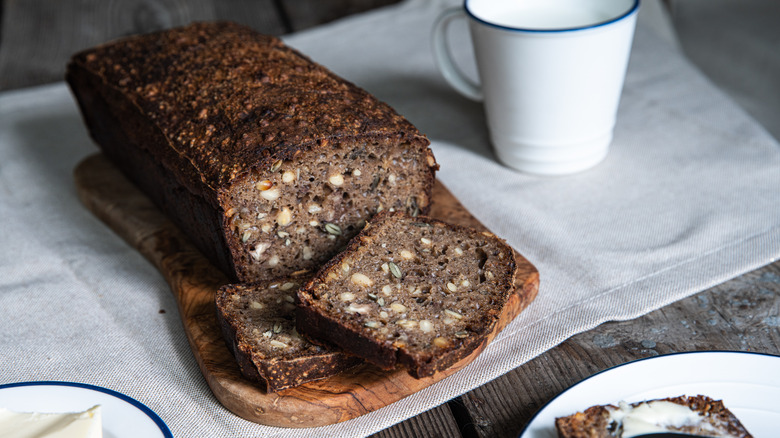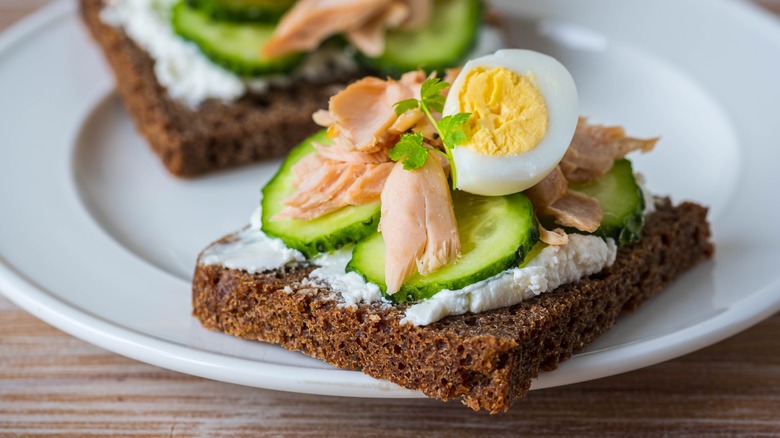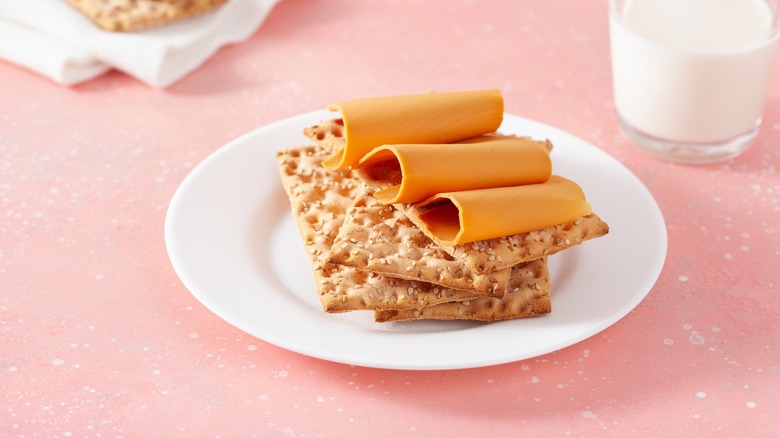Why Rye Bread Is Completely Different In Scandinavia
Rye bread: The name is pretty obvious, right? It's bread that's made from rye, a cereal crop that's related to wheat, and which grows around the world, especially in colder northern climates (and particularly in Europe).
But in America, the term "rye bread" is a bit of a misnomer: What's sold as rye bread in the States is commonly made with more wheat flour than rye flour (with rye flour often making up just a fifth of the recipe). Head across the pond, and particularly to countries like Denmark, Sweden, and Norway, and you'll find that rye bread is a much darker color and more moist, as it's regularly made with 100% rye flour.
It was immigrants from these areas who brought rye bread to the U.S., but their pure rye bread fell out of favor in the early 20th century, due to perceptions that rye bread was an undesirable German food, amidst the World Wars. But this dense bread is common in diets across the so-called "rye belt," especially in Scandinavia, where many people eat some form of rye bread quite literally every day.
Rugbrød: the ultimate rye bread?
Because of differences in the type of gluten in rye, rye breads can be quite heavy and moist: They don't rise as much, so the loaves will typically be smaller than wheat-based bread.
This is certainly the case with rugbrød (literally "rye bread"), a hearty bread that makes up part of the daily diet of many Danes. In fact, up until 2019, the bread was the most popular evening meal for Danes. It's made with wholegrain rye flour, sometimes as a sourdough loaf, and sometimes with seeds or a little wheat mixed in. It needs a longer amount of time to rise and tends to have a more distinctive flavor than American rye bread, with sour or bitter notes.
Rugbrød is regarded as particularly healthy, thanks to its high fiber content and low levels of fat and sugar. It's often eaten with just a generous smear of butter, but its robust structure also makes it a key part of the quintessentially Danish smørrebrød, an open sandwich (with a slice of rugbrød as the base) stacked with anything from herring to liver pâté, eggs, or cheese (not all at once, naturally).
Other Scandinavian rye breads to know
The dark, savory rugbrød isn't the only Nordic rye bread in town: Other countries in the region have their own ways with rye. For example, head across the border to Sweden, and you'll find a popular bread called kavring. It's lighter (since it uses a mix of wheat and rye flours) but also sweeter, with syrup in the recipe, as well as caraway or fennel for flavoring. Like rugbrød, it may be served with smoked fish and savory foods, but also at breakfast with jam or cheese.
Over in Norway, you'll also find knekkebrød on the menu. It's really a crispbread (think hearty cracker), but it's still used similarly to rugbrød or kavring, stacked with toppings like eggs or fish. It's made with a mix of rye and wheat flour, oats, and seeds.
There's also pumpernickel. While it's German and not Scandinavian, it's arguably the European rye bread that Americans will be most familiar with. However, American pumpernickel isn't the same as what you'll find across the Atlantic. In Germany, pumpernickel is usually entirely made with rye flour (making it somewhat similar to rugbrød) — whereas, in America, it's mixed with wheat flour and sometimes artificially colored to appear darker.



